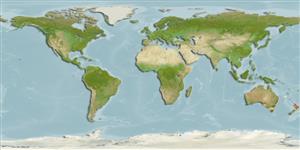>
Perciformes/Serranoidei (Groupers) >
Epinephelidae (Groupers)
Etymology: Epinephelus: Greek, epinephelos = cloudy (Ref. 45335).
Eponymy: Eduard C F Dämle, also known as Dämel or Daemel (1821–1900), was a German entomologist, and a collector and dealer in natural history specimens. [...] (Ref. 128868), visit book page.
More on author: Günther.
Environment: milieu / climate zone / depth range / distribution range
Ecologie
marien rifbewoner; diepte ? - 50 m (Ref. 5222). Subtropical; 25°S - 43°S, 136°E - 177°W (Ref. 5222)
Southwest Pacific: Australia, Lord Howe Island, Norfolk Island, Kermadec Islands and New Zealand (North Island and Poor Knights Island). The Australian range extends from southern Queensland to Kangaroo Island off South Australia; also reported from the Bass Strait.
Grootte / Gewicht / Leeftijd
Maturity: Lm ? range ? - ? cm
Max length : 200 cm TL mannelijk / geslacht onbekend; (Ref. 9710); max. gepubliceerd gewicht: 68.0 kg (Ref. 4787)
Dorsale stekels (totaal) : 9; Dorsale zachte stralen (totaal) : 14; Anale stekels: 3; Anale zachte stralen: 8.
Found on rocky substrata from near shore to at least 50 m. It is an aggressive territorial species that may occupy a particular cave for life. Small individuals feed on crabs and small fishes. Sexual transition reported to occur at 100-110 cm (Ref. 6787). Large individuals are often attracted by divers (Ref. 9710). An esteemed food fish avidly sought by anglers and spear fishermen.
Levenscyclus en paargedrag
Maturiteit | Voortplanting | Paaien | Eieren | Fecunditeit | Larven
Heemstra, P.C. and J.E. Randall, 1993. FAO Species Catalogue. Vol. 16. Groupers of the world (family Serranidae, subfamily Epinephelinae). An annotated and illustrated catalogue of the grouper, rockcod, hind, coral grouper and lyretail species known to date. Rome: FAO. FAO Fish. Synop. 125(16):382 p. (Ref. 5222)
Status op de Rode Lijst van het IUCN (Ref. 130435: Version 2024-1)
Gevaar voor de mens
Harmless
Gebruik door de mens
Visserij: visserij voor eigen gebruik; sportvis: ja
Tools
Speciale rapporten
Download XML
Internetbronnen
Estimates based on models
Preferred temperature (Ref.
123201): 16.4 - 24.3, mean 17.9 °C (based on 56 cells).
Fylogenetische diversiteitsindex (Ref.
82804): PD
50 = 0.5000 [Uniqueness, from 0.5 = low to 2.0 = high].
Bayesian length-weight: a=0.01175 (0.00568 - 0.02430), b=3.04 (2.88 - 3.20), in cm total length, based on LWR estimates for this Genus-body shape (Ref.
93245).
Trofisch niveau (Ref.
69278): 4.0 ±0.70 se; based on food items.
Weerstandsvermogen (Ref.
120179): Zeer laag, minimale populatieverdubbelingstijd meer dan 14 jaar (Preliminary K or Fecundity.).
Fishing Vulnerability (Ref.
59153): Very high vulnerability (90 of 100).
Nutrients (Ref.
124155): Calcium = 7.69 [2.83, 18.19] mg/100g; Iron = 0.356 [0.177, 0.770] mg/100g; Protein = 19.4 [17.8, 20.9] %; Omega3 = 0.139 [0.071, 0.276] g/100g; Selenium = 23.2 [10.1, 51.6] μg/100g; VitaminA = 61.1 [13.9, 265.1] μg/100g; Zinc = 0.665 [0.427, 1.019] mg/100g (wet weight);
